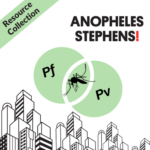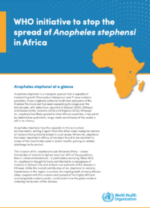DEEP DIVE
Anopheles stephensi
21/02/2022
07/03/2025
This is an active Deep Dive and we welcome your contributions! If you are currently involved or planning research and / or programatic activities on Anopheles stephensi please contact MESA (mesa@isglobal.org) or add your project to the database.
——
The Anopheles stephensi mosquito, traditionally an Asian malaria vector, has undergone a significant shift in its global distribution. Recent appearances in various parts of Africa, Sri Lanka, and Yemen highlight its expanding range. Originally confined to South-East Asia and the Arabian Peninsula, An. stephensi’s presence in Djibouti (2012), Ethiopia (2016), Sri Lanka (2017), Sudan (2019), Somalia (2019), Nigeria (2020), Yemen (2021), Kenya (2022), Eritrea (2022) and Ghana (April 2023) demonstrates its unprecedented spread (ref).
Recognizing An. stephensi’s emergence as a major biological threat to malaria control, the World Health Organization (WHO) has taken several significant steps. A vector alert was first issued in August 2019 (ref), emphasising the urgent need for surveillance and control measures, and was later updated in January 2023 to reflect the latest developments (ref). Additionally, the WHO launched a dedicated initiative in September 2022, aimed at halting the spread of An. stephensi in Africa (ref), which was subsequently updated in August 2023 to incorporate new strategies and insight (ref). Another critical tool developed by the WHO is the Malaria Threat Map, a tracking platform designed to monitor the distribution and impact of An. stephensi and other biological threats to malaria control(ref).
As an efficient urban malaria vector, capable of transmitting both Plasmodium falciparum and Plasmodium vivax, An. stephensi’s resistance to insecticides and drugs, and its role in diagnosis-resistance present significant challenges (ref). Its adaptability to both indoor and outdoor environments in urban settings exacerbates the issue. Rapid urbanisation, with an increase in construction sites with water storage containers, and sub-optimal planning, including poor garbage disposal and disrupted water supply, create breeding grounds for An. stephensi, necessitating focused research and response efforts (ref, ref, ref).
Advanced vector surveillance training, continuous molecular monitoring, DNA sequencing techniques, and in-depth research are essential for comprehending the spread, climate change impact, transmission dynamics, and behavioural patterns of An. stephensi in novel environments (ref, ref, ref).
This Deep Dive which is done in collaboration with the Roll Back Malaria Vector Control Working Group (RBM VCWG) aims to describe the landscape of recent and ongoing An. stephensi research and investment. We hope it will be beneficial in identifying any existing knowledge gaps.

Total
projects

Total funding
amount



